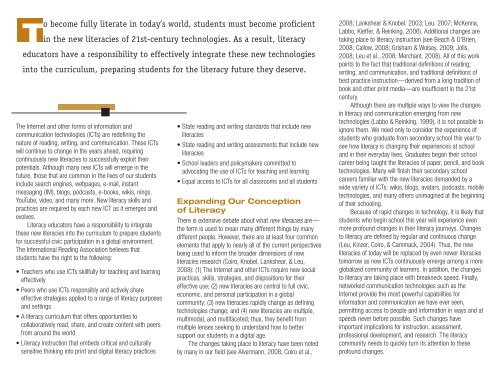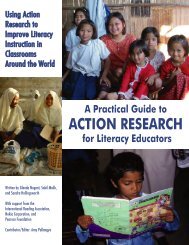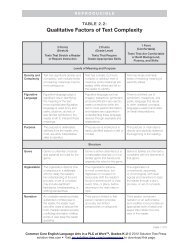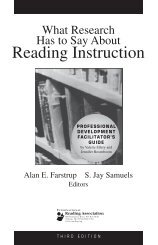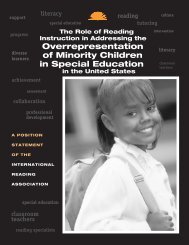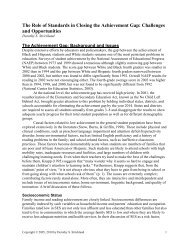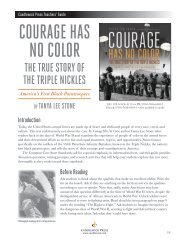New Literacies and 21st-Century Technologies position statement
New Literacies and 21st-Century Technologies position statement
New Literacies and 21st-Century Technologies position statement
Create successful ePaper yourself
Turn your PDF publications into a flip-book with our unique Google optimized e-Paper software.
To become fully literate in today’s world, students must become proficient<br />
in the new literacies of <strong>21st</strong>-century technologies. As a result, literacy<br />
educators have a responsibility to effectively integrate these new technologies<br />
into the curriculum, preparing students for the literacy future they deserve.<br />
The Internet <strong>and</strong> other forms of information <strong>and</strong><br />
communication technologies (ICTs) are redefining the<br />
nature of reading, writing, <strong>and</strong> communication. These ICTs<br />
will continue to change in the years ahead, requiring<br />
continuously new literacies to successfully exploit their<br />
potentials. Although many new ICTs will emerge in the<br />
future, those that are common in the lives of our students<br />
include search engines, webpages, e-mail, instant<br />
messaging (IM), blogs, podcasts, e-books, wikis, nings,<br />
YouTube, video, <strong>and</strong> many more. <strong>New</strong> literacy skills <strong>and</strong><br />
practices are required by each new ICT as it emerges <strong>and</strong><br />
evolves.<br />
Literacy educators have a responsibility to integrate<br />
these new literacies into the curriculum to prepare students<br />
for successful civic participation in a global environment.<br />
The International Reading Association believes that<br />
students have the right to the following:<br />
• Teachers who use ICTs skillfully for teaching <strong>and</strong> learning<br />
effectively<br />
• Peers who use ICTs responsibly <strong>and</strong> actively share<br />
effective strategies applied to a range of literacy purposes<br />
<strong>and</strong> settings<br />
• A literacy curriculum that offers opportunities to<br />
collaboratively read, share, <strong>and</strong> create content with peers<br />
from around the world<br />
• Literacy instruction that embeds critical <strong>and</strong> culturally<br />
sensitive thinking into print <strong>and</strong> digital literacy practices<br />
• State reading <strong>and</strong> writing st<strong>and</strong>ards that include new<br />
literacies<br />
• State reading <strong>and</strong> writing assessments that include new<br />
literacies<br />
• School leaders <strong>and</strong> policymakers committed to<br />
advocating the use of ICTs for teaching <strong>and</strong> learning<br />
• Equal access to ICTs for all classrooms <strong>and</strong> all students<br />
Exp<strong>and</strong>ing Our Conception<br />
of Literacy<br />
There is extensive debate about what new literacies are—<br />
the term is used to mean many different things by many<br />
different people. However, there are at least four common<br />
elements that apply to nearly all of the current perspectives<br />
being used to inform the broader dimensions of new<br />
literacies research (Coiro, Knobel, Lankshear, & Leu,<br />
2008): (1) The Internet <strong>and</strong> other ICTs require new social<br />
practices, skills, strategies, <strong>and</strong> dis<strong>position</strong>s for their<br />
effective use; (2) new literacies are central to full civic,<br />
economic, <strong>and</strong> personal participation in a global<br />
community; (3) new literacies rapidly change as defining<br />
technologies change; <strong>and</strong> (4) new literacies are multiple,<br />
multimodal, <strong>and</strong> multifaceted; thus, they benefit from<br />
multiple lenses seeking to underst<strong>and</strong> how to better<br />
support our students in a digital age.<br />
The changes taking place to literacy have been noted<br />
by many in our field (see Alvermann, 2008; Coiro et al.,<br />
2008; Lankshear & Knobel, 2003; Leu, 2007; McKenna,<br />
Labbo, Kieffer, & Reinking, 2006). Additional changes are<br />
taking place to literacy instruction (see Beach & O’Brien,<br />
2008; Callow, 2008; Grisham & Wolsey, 2009; Jolls,<br />
2008; Leu et al., 2008; Merchant, 2008). All of this work<br />
points to the fact that traditional definitions of reading,<br />
writing, <strong>and</strong> communication, <strong>and</strong> traditional definitions of<br />
best practice instruction—derived from a long tradition of<br />
book <strong>and</strong> other print media—are insufficient in the <strong>21st</strong><br />
century.<br />
Although there are multiple ways to view the changes<br />
in literacy <strong>and</strong> communication emerging from new<br />
technologies (Labbo & Reinking, 1999), it is not possible to<br />
ignore them. We need only to consider the experience of<br />
students who graduate from secondary school this year to<br />
see how literacy is changing their experiences at school<br />
<strong>and</strong> in their everyday lives. Graduates began their school<br />
career being taught the literacies of paper, pencil, <strong>and</strong> book<br />
technologies. Many will finish their secondary school<br />
careers familiar with the new literacies dem<strong>and</strong>ed by a<br />
wide variety of ICTs: wikis, blogs, avatars, podcasts, mobile<br />
technologies, <strong>and</strong> many others unimagined at the beginning<br />
of their schooling.<br />
Because of rapid changes in technology, it is likely that<br />
students who begin school this year will experience even<br />
more profound changes in their literacy journeys. Changes<br />
to literacy are defined by regular <strong>and</strong> continuous change<br />
(Leu, Kinzer, Coiro, & Cammack, 2004). Thus, the new<br />
literacies of today will be replaced by even newer literacies<br />
tomorrow as new ICTs continuously emerge among a more<br />
globalized community of learners. In addition, the changes<br />
to literacy are taking place with breakneck speed. Finally,<br />
networked communication technologies such as the<br />
Internet provide the most powerful capabilities for<br />
information <strong>and</strong> communication we have ever seen,<br />
permitting access to people <strong>and</strong> information in ways <strong>and</strong> at<br />
speeds never before possible. Such changes have<br />
important implications for instruction, assessment,<br />
professional development, <strong>and</strong> research. The literacy<br />
community needs to quickly turn its attention to these<br />
profound changes.


